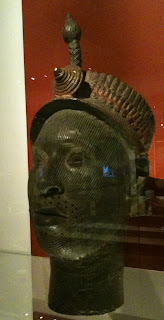West African civilization.
This gorgeous sculpted head of a king of Ife, in what is now Nigeria, wasn’t unearthed until the 1920s, at which point Leo Frobenius, the German archeologist who discovered it, said it was proof that Greek culture originated on the island of Atlantis. The Atlantans must have sent some of their great artists and sculptors both to Greece, founding the great Greek culture that everyone knows and studies, and also to this part of west Africa, since, as everyone knew, the Africans themselves could never have come up with a great artistic masterpiece.
Wow. That’s all anyone can say. A scholar wrote that? I suppose it’s more a testament to the racism of the 1920s than anything else—the period that gave us the KKK, Porgy and Bess, and got the world ready for the Nazis. The US Civil War, in a funny way, increased racism, at least for a few generations, by ending slavery in name but not necessarily in practice. I think WWII did more to end it in practice, and at least get racism out in the open where everybody could see it. So...how many other great archeological or artistic finds have gone nowhere because they happened at the wrong time?
In any event, MacGregor & friends have a nice podcast on this beautiful head, which as you can see is a masterpiece of realism and human character and also strongly stylized. One expert in African sculpture who speaks here says that it’s typical for a head, which is the seat of the soul/mind/etc. in the understanding of many of these groups, to take up a quarter of a sculpture of a person. They don’t know if there was a body attached to this particular head at any point. But if you’re familiar with any African sculptures, like the masks we’ve got at the Seattle Art Museum, you’re familiar with the kind of stylization referred to here—and with stylization in art, you never know if the artist COULD do a different style and just chose not to. If you assume that isn’t the case, it’s easy to jump to the conclusion that the artist with a distinctive stylization is inferior, a child scrawling its own drivel rather than appreciate the masters. I suspect that’s the real story of the early 20th-century fascination with African art, among modern artists (and hateful back-reaction on the part of the racist mainstream).
For Africans, artifacts like this head are of course hugely important in trying to get a sense of history, and thence self-identification. How do you know who you are, if you don’t know where you came from and what happened there? (Or, put another way: in The Two Towers Treebeard explains that he can’t say his name to the hobbits in Old Entish, the language he uses to speak to other trees, because his name is the story of his life, everything that has ever happened to him, every squirrel that’s ever run through his leaves, and thus merely to say his name would take hundreds of years.) The Ife Kingdom where this head was created didn’t leave us any writing, so we know very little about them, historically speaking. But you don’t create a masterwork of art like this without a strong, vigorous culture. A tantalizing glimpse of something mighty interesting going on there at one point.


No comments:
Post a Comment